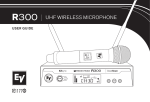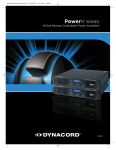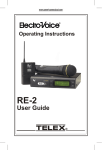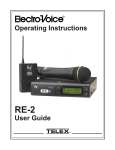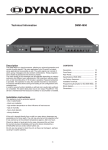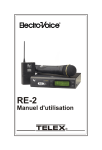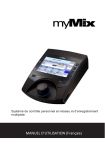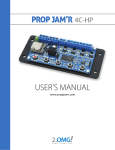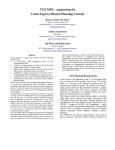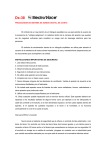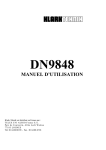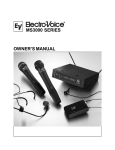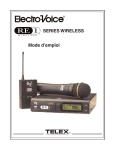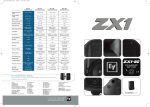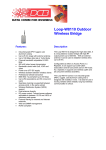Download R300 - Scandec Systemer
Transcript
R300 UHF WIRELESS MICROPHONE USER GUIDE CHANNEL MUTE SYNC MHz EZsync R300R300 Electro-Voice Clear ClearScan SYNC SET 1177 2 TABLE OF CONTENTS 1. Quick Set–up • Receiver. . . . . . . . . . . . . . . . . . . . . . . . . . . . . . . . . . . . . . . . . . . . . . . . . . . . . . . . . . . . . . . . . . . . . . . . . . . . . . . . . . . . . . . . . . . . . . . . . . . . . . . . . . . . . . . . . . 4 • Transmitter. . . . . . . . . . . . . . . . . . . . . . . . . . . . . . . . . . . . . . . . . . . . . . . . . . . . . . . . . . . . . . . . . . . . . . . . . . . . . . . . . . . . . . . . . . . . . . . . . . . . . . . . . . . . . . 5 • Systems Operation. . . . . . . . . . . . . . . . . . . . . . . . . . . . . . . . . . . . . . . . . . . . . . . . . . . . . . . . . . . . . . . . . . . . . . . . . . . . . . . . . . . . . . . . . . . . . . . 6 2. Detailed Component Descriptions • Receiver. . . . . . . . . . . . . . . . . . . . . . . . . . . . . . . . . . . . . . . . . . . . . . . . . . . . . . . . . . . . . . . . . . . . . . . . . . . . . . . . . . . . . . . . . . . . . . . . . . . . . . . . . . . 7-14 • Handheld Transmitter. . . . . . . . . . . . . . . . . . . . . . . . . . . . . . . . . . . . . . . . . . . . . . . . . . . . . . . . . . . . . . . . . . . . . . . . . . . . . . . . . . 15-16 • Bodypack Transmitter. . . . . . . . . . . . . . . . . . . . . . . . . . . . . . . . . . . . . . . . . . . . . . . . . . . . . . . . . . . . . . . . . . . . . . . . . . . . . . . . . 17-19 3. Guidelines and Recommendations For Best Performance. . . . . . . . . . . . . . . . . . . . . . . . . . . . . . . . 20-21 4. Troubleshooting Guide. . . . . . . . . . . . . . . . . . . . . . . . . . . . . . . . . . . . . . . . . . . . . . . . . . . . . . . . . . . . . . . . . . . . . . . . . . . . . . . . . . . . . . . . . . . . . . 22-23 5. Frequently Asked Questions. . . . . . . . . . . . . . . . . . . . . . . . . . . . . . . . . . . . . . . . . . . . . . . . . . . . . . . . . . . . . . . . . . . . . . . . . . . . . . . . . . . . 24-26 6. Components and Accessories.. . . . . . . . . . . . . . . . . . . . . . . . . . . . . . . . . . . . . . . . . . . . . . . . . . . . . . . . . . . . . . . . . . . . . . . . . . . . . . . . . . . . . . 27 7. Compatible Channel Frequency Groups.. . . . . . . . . . . . . . . . . . . . . . . . . . . . . . . . . . . . . . . . . . . . . . . . . . . . . . . . . . . . . . . 28-31 8. Specifications . . . . . . . . . . . . . . . . . . . . . . . . . . . . . . . . . . . . . . . . . . . . . . . . . . . . . . . . . . . . . . . . . . . . . . . . . . . . . . . . . . . . . . . . . . . . . . . . . . . . . . . . . . . . . 32-33 9. Certifications.. . . . . . . . . . . . . . . . . . . . . . . . . . . . . . . . . . . . . . . . . . . . . . . . . . . . . . . . . . . . . . . . . . . . . . . . . . . . . . . . . . . . . . . . . . . . . . . . . . . . . . . . . . . . . . . . . . . . . 34 10. Factory Service. . . . . . . . . . . . . . . . . . . . . . . . . . . . . . . . . . . . . . . . . . . . . . . . . . . . . . . . . . . . . . . . . . . . . . . . . . . . . . . . . . . . . . . . . . . . . . . . . . . . . . . . . . . . . . . . . 35 3 01 QUICK SET-UP: RECEIVER 1. Do not connect the receiver to any other equipment yet! 2. Connect the two Antennas to the receiver. 3. Install the blades into the power supply, plug it into the back of the receiver, and into an outlet. 4. Press the POWER switch. Display will light up. 5. Press and hold the 6. When CLEARSCAN stops, the receiver will be set to the clearest channel. 7. Mute the Audio Mixer channel where the receiver will be plugged in, or set it to minimum. 8. Leave the receiver ON and connect it to the audio system using either the XLR connector or ¼-inch line level jack. button until CLEARSCAN scrolls across the screen. Receiver “Quick Set-up” is complete. 4 QUICK SET-UP: TRANSMITTER 1. With the Power switch on the transmitter OFF, install two fresh AA batteries into the transmitter. 2. Press the transmitter Power Switch until the display comes on. 3. Loosen the transmitter battery cover to expose the EZsync Port, as shown. R300 EZsync ClearScan SYNC EZsync CHAN NEL MUTE SYNC SET R300 Clear SYNC SET MHz 4. Hold the transmitter with the EZsync Port facing the receiver, about a foot (30 cm) away.* 5. Press the SYNC Button on the receiver, SYNC will show in the display. 6. nce the channel is set in the transmitter, the display will switch to the main O display and show RF and Audio Levels. *Note: When performing EZsync, make sure lighting conditions are not too bright. Extremely bright lighting can interfere with EZsync. Transmitter “Quick Set-up” is complete. 5 01 QUICK SET-UP: SYSTEMS OPERATION 1. Set the mixer/amp gain. 2. Talk or sing into the microphone or play the guitar at a normal volume. You should hear audio coming out of the system. 3. ou may have to adjust the gain (via the control next to the connector on the Y receiver back panel) to provide the best input volume for your mixer/amp. Notes: • See page 10 of this manual for more information. • See Image 11 of the Quick Start Guide for gain control location. “Quick Set-up” is now complete. Please enjoy your R300 system. 6 DETAILED COMPONENT DESCRIPTIONS 02 2.1 | R300 Receiver RECEIVER CONTROLS, CONNECTORS 1. Power ON/OFF 2. SYNC Data Transfer Button 3. Infrared EZsync Window 4. Graphical Display a. Channel or Frequency Display b.Diversity Indicator c. RF Strength Meter d.Audio Level Meter e. Lock Indicator f. Squelch Level Indicator EZsync R300R300 Electro-Voice 5. 6. 7. 8. 9. 10. 11. 12. 13. 14. Scroll Down and Up ( and ) Control Buttons SET Control Button ClearScan Control (press and hold button) TNC Antenna Input Connectors (2) Audio Output Volume Control XLR Balanced Output Connector ¼ Inch Unbalanced Line Level Audio Output Connector Unbalanced Output Level Switch (-10dB or 0dB) DC Power Connector (12V DC, 500mA) Power Cord Retainer -10dB Clear ClearScan SYNC SET ANTENNA B 8 MIN MAX VOLUME 9 0dB LEVEL BALANCED OUT UNBALANCED OUT 10 11 12V 12 .500mA 13 ANTENNA A 14 8 7 02 DETAILED COMPONENT DESCRIPTIONS 2.1 | Receiver Setup & Operation 1. Place the receiver and antennas where there is a clear line of sight to the area where the transmitter will be used. Rotate the antennas to separate them by 90 degrees. 2. I nstall the appropriate power connection blades into the power supply and connect the power supply cord to the receiver. Plug the power supply into an AC outlet. Push the power button to turn the receiver on and confirm that it is on by checking the main display screen. -10dB ANTENNA B 3. 8 MIN MAX VOLUME 0dB LEVEL BALANCED OUT UNBALANCED OUT 12V .500mA ANTENNA A Manual Channel Change a. The and buttons allow you to scroll through the Channels. When the Channel you desire is displayed, stop scrolling. b.After 2 seconds the displayed channel number will start to flash. c. The number will stop flashing and the new channel is installed. d.Turn on the transmitter and hold the EZsync port facing the receiver EZSync port, about a foot (30 cm) away, as described on page 5. continued on next page EZsync SYNC R300 ClearScan EZsync R300 Clear SYNC SET CHAN NEL MUTE SYNC SET MHz e. Press the SYNC button on the receiver to transfer the channel information. f. The receiver will display SYNC until the data is transferred, then return to the main screen. g.The transmitter display screen will now show the new channel and frequency. NOTE: 1. If the channel data was not transferred to the transmitter after 5 seconds, the receiver will display ERROR. Be certain that the transmitter is On and the EZsync port is facing the receiver and try again. 2. If the data still does not transfer, try new batteries, or move the unit to a shaded area away from direct sunlight or bright lights before trying again. continued on next page 9 02 DETAILED COMPONENT DESCRIPTIONS 4. ClearScan: This feature automates the process of finding a clear channel. a. .To scan for the clearest channel in a group, press and hold until CLEARSCAN appears in the display, then release the button. b.When the scan is complete, the display will show the clearest available channel. c. Use the SYNC button to transfer the new channel as in step 3. 5. During set up make sure the mixer or amplifier input used for the R300 is muted or turned down to a minimum level. 6. Plug an audio cable (not supplied) into the 3 pin XLR or ¼-inch TRS output of the R300. Note: 10 The XLR connector is the preferred connection since the output is balanced and will be more immune to noise for longer runs of cable although either can be used with good results. Set the balanced output level on the back panel to 12 o’clock (midway in the range) to start and adjust later if necessary. If the ¼-inch unbalanced output is used, start with adjustment switch in the -10dB setting. continued on next page 7. With the transmitter on, speak into the microphone or play the guitar. Turn up the level on the mixer or amplifier until you are able to hear the desired signal. If no audio is present, repeat setup and refer to the troubleshooting section. Note: 8. It may be necessary to adjust the receiver output until the volume level from the wireless system approximates the level of an equivalent wired microphone/instrument. DISPLAY The main display can be adjusted to display the Channel number or the Frequency. Note: At any time the item not selected for the main display can be shown for 5 seconds by pushing the SET button once. a. Press and hold the SET button until DISPLY shows in the display. b.Press SET and FREQUENCY or CHANNEL will flash in the display. c. Press for FREQUENCY or for CHANNEL and press SET. d.Display will return to the main screen and the selected item will be displayed. e. At any time the item not selected for the main display can be shown for 5 seconds by pushing the SET button once. continued on next page 11 02 DETAILED COMPONENT DESCRIPTIONS 9. hange Lock-Out This feature can be useful when the receiver is in a location where unauthorized C personnel have access to the receiver. With the LOCK ON, the channel cannot be changed and the word LOCK is displayed when the or button is pushed. a. Press and hold the SET button until DISPLY shows in the display. b.Press to display LOCK. c. Press SET and ON or OFF will be displayed to show the status of the lock-out. d.Press to turn the LOCK ON or to turn the LOCK OFF and press SET. e. Display will return to the main screen and padlock symbol in the upper left of the display will show the lock status. 12 continued on next page 10. Squelch Adjustment – The squelch setting can be used to maximize range or immunity to noise. a. Turn the transmitter off. b.On the receiver, press and hold the SET button until DISPLY shows in the display. c. On the receiver, press two times to display SQELCH. d.On the receiver, press SET and the squelch setting in the middle right of the screen (SQ 10dB) will flash. e. On the receiver, press to decrease the squelch setting or to increase it. f. On the receiver, press SET to enter the new setting and return to the main screen. g.Turn on the transmitter and walk test the unit. Maximum squelch (50dB) maximizes noise immunity but limits the range. Minimum squelch (5dB) will maximize the range but allow more noise to break through the squelch. Never leave the squelch set to 0dB except for testing, white noise will be constantly present on the audio outputs. h. Repeat to fine tune receiver squelch to the desired setting. 13 02 DETAILED COMPONENT DESCRIPTIONS 2.1.2 | Receiver Main Operating Screen Display: 1. RF Signal Meter 2. Audio Meter 3. Lock Indicator 4. No Signal Indicator 5. Channel Number (01 to 32) or Frequency 6. Squelch Setting 7. Antenna Diversity Status A or B antenna Controls: 1. Press or to change channels 2. Press and hold for 3 seconds starts ClearScan, CLEARSCAN scrolls across the display 3. Press SET once to display FREQUENCY or CHANNEL, whichever is not showing 4. Press and hold SET for 3 seconds to access settings menu 14 2.2 | Handheld Transmitter HT-300 CONTROLS, CONNECTORS AND INDICATORS 1. Microphone Element 2. Backlit LCD Display a. Channel b. Frequency c. Battery Level d. Mute Indicator 3. EZSync Infrared Port 4. Battery Cover – Screw type 5. Battery Compartment – Two AA Batteries 6. On/Off/Mute button 15 02 DETAILED COMPONENT DESCRIPTIONS 2.2 | Handheld Transmitter Setup & Operation 1. Insert Batteries. a. Remove the battery compartment cover by unscrewing it completely. b. .Insert two AA batteries as shown, sliding one up into the housing to make room for the other making sure to follow polarity, as marked. 2. Turn the unit on by pressing and holding the on/off button for 3 seconds, and the display will light up. 3. If a new channel is desired, use EZsync as in Section 2.1 and close battery compartment. 4. Verify reception. a. With the transmitter and receiver on a matching Channel, the main receiver display should be indicating a RF signal on the bar graph. b. Speak into the microphone and the Audio Meter bar graph should indicate audio signal presence. c. .If the level meters do not show reception, make sure the channels are matching and refer to the troubleshooting section. 16 5. ute Function – press and hold on/off button for 2 seconds until MUTE appears in the LCD M display and sound mutes. Repeat to turn mute off. 2.3 | Bodypack Transmitter 1 3 4 7 1 2 5 6 9 8 BP-300 CONTROLS, CONNECTORS AND INDICATORS 1. Antenna – Flexible ¼ wave antenna 2. Power On/Off/Mute Button 3. TA4 Microphone Connector 4. On/Mute LED – Green when transmitter is on, Red when muted continued on next page 17 02 DETAILED COMPONENT DESCRIPTIONS 2.3 | Bodypack Transmitter continued 5. LCD Display a. Channel b. Frequency c. Battery Level d. Mute Indicator 6. EZsync infrared window 7. Battery Compartment Latch – push down latch and slide cover as shown 8. Two AA Battery Compartment – follow polarity as marked 9. LAV/INS Gain Switch 18 2.3.1 | Bodypack Transmitter Setup & Operation 1. Insert Batteries a. O . pen the battery compartment by pressing in on the latch and sliding the door down. b. Insert two AA batteries with + and – as indicated. c. Close the battery door by pushing up. 2. urn the unit on by pressing and holding the on/off button for 3 seconds, and the LCD display T will light up. If channel has not been set, set channel according to 2.1. 3. Microphone/Guitar Operation. a. For Lapel the gain switch should be in the LAV position. b. For Headworn Microphones the gain switch should be in the INS position. c. If lapel microphones are too sensitive and the audio meter on the receiver is reaching the peak, put the gain switch in INS to lower the gain. d. For guitar operation using the optional R300GTRCBL cable, the gain switch should be in the LAV position for passive pickups, and in the INS position for active pickups. Should the output of the passive pickups be too high in the LAV position, switch to the INS position for reduced transmitter input gain. 4. Mute Function – press and hold on/off button for 2 seconds until MUTE appears in the LCD display, On LED turns red, and sound mutes. Repeat to turn mute off. 19 03 GUIDELINES AND RECOMMENDATIONS For Best Performance Compatibility The transmitter and receiver must be of the same frequency band and set to the same channel in order to work together. The R300 is available in four frequency bands, A, B, C and E (Europe only). The band information is available in the serial number label on the receiver, the serial number label on the handheld transmitter, and on the back panel label on the bodypack. Using Multiple Wireless Systems If three or more R300 systems and/or other UHF/VHF wireless systems are being used in the same location, proper frequency coordination is necessary to avoid interference. Some channels in the R300 are designed to work together, see the channel groups in the back of this guide for more information. Contact your dealer or Electro-Voice for assistance if you are planning more systems or using the R300 with other wireless equipment. Multiple Systems and R300 The ClearScan function can be used to set up any two R300 systems. Just scan with the first unit receiver, set the transmitter to that clear channel and leave it on. Then scan the second unit receiver for another clear channel. If 3 or more systems in the same frequency band are used in the same room, put all of the channels in the same group as indicated by the channel groups on page 28-31. Potential Sources of Interference There are many potential sources of interference for your wireless system. Any electronic product that contains digital circuitry including digital signal processors (reverb/multi-effects units), electronic keyboards, digital lighting controllers, CD and DVD players, and computers, all emit RF energy that can 20 adversely affect the performance of your wireless system. It is always best to place the receiver as far away as possible from these devices to minimize potential problems. Analog and Digital Television stations can also interfere with your wireless system. The R300 is designed to operate over 16MHz of RF bandwidth, which covers 3 US TV stations. If two of the three stations are used in your area, it will severely limit the number of systems that will operate together and you should be using a different band. Battery Recommendations Fresh AA alkaline batteries from a quality manufacturer will yield the best performance from your R300 transmitters. If sound quality degrades during use, it may be the result of a weakening battery. Receiver and Antenna Placement Do not place the receiver near a large metal object or surface. Locate the receiver as close as possible to the area where the transmitter will be used. Ideally, position the receiver/antennas within sight of the transmitter. When using multiple systems, do not allow antennas to cross or touch each other. Transmitter and Antenna Distance Keep all transmitters at least 3 meters (10ft) away from the receivers and antennas for best operation. If possible, mount the receiver antennas 3 meters (10ft) above the stage so transmitters can not come too close. 21 04 TROUBLESHOOTING GUIDE Problem Possible Causes No audio and no display on the receiver Receiver is off Transmitter is off Make sure that the power supply is properly connected and the on/off button is in the on position. Turn on transmitter power switch. No audio and no RF signal indicator on the receiver display Transmitter is on a different channel or is a different band Check band information on serial number label and match to receiver, reset channel (see section 2.1). No (or dead) battery in transmitter Faulty battery contacts No Audio with good RF signal indicator Microphone not connected Insert fresh batteries in transmitter. Clean and or bend contacts to improve connection. Check the TA4F connector on the bodypack or the detachable microphone element connection on the handheld. If possible, try another microphone. Press and hold On/Off button to stop Mute. No (or low) Audio with good RF signal and Audio indicators on receiver display Distorted audio signal Interference 22 Solutions Transmitter Mute On Receiver audio output cable is damaged or disconnected Gain not sufficient on mixer/preamp/amp input or it is muted Receiver output too low Receiver output too high Loud instrument or audio source Battery level low in transmitter Another R300 system in the installation is on the same channel or signals are mixing. Connect, repair or replace audio output cable. Increase gain on mixer or un-mute the input. Increase the audio output setting. Decrease the receiver output setting. Change the bodypack gain switch to INS. Insert fresh batteries in transmitter. Make certain all units are on different channels. See Frequently Asked Questions section for more helpful information. Problem Interference Possible Causes Another wireless product in the area is on the same frequency or the signals are mixing Receiver is too close to digital signal processor or similar device Strong electromagnetic field from stage lighting or other source near the transmitter or receiver, which may be producing RF noise at or near the operating frequency RF reflective metal obstacles between the transmitter and receiver Poorly oriented beltpack antenna Short range or drop-outs Squelch set too high Faulty receiving antenna system Can't change settings on receiver Transmitter will not sync with receiver Lockout feature is enabled Battery cover on handheld Lighting in environment is too bright Solutions Use ClearScan to change the operating frequency. Move the receiver to a different location. Use ClearScan to change the operating frequency. Repair or remove the source of interference. Move the receiver to a different location. Move the obstacles, or reposition the receiver/antennas. Check the antenna connection and reorient the bodypack so the antenna is vertical (up and down) and facing the receiver, if possible. Check squelch setting, higher numerical settings mean shorter range (see page 13). Check all antenna connections and reposition to be in line-of-sight with the transmitter. Disable lockout by pressing SET for 3 seconds, press to display LOCK, press SET, press to turn lock off, press SET. Remove battery cover, see page 15 for location of EZsync window. Shadow infrared ports from light. 23 05 FREQUENTLY ASKED QUESTIONS Frequently Asked Questions Q: How can I make sure my R300 system’s frequency band will work in my location? A: If you will be using your system in the USA, you can check R300 compatibility in your location by using the frequency band selector located at http://www.electrovoice.com/frequencyselector. If you are outside of the USA, please contact your local Electro-Voice dealer or technical support center. Q: Are there any web-based materials or how-to’s available which will help me understand my R300 system? A: R300 how-to videos are posted at http://www.electrovoice.com/evtv.php?category=knowledge Q: How many R300 systems can I operate at the same time? A: The number of R300 systems you can operate simultaneously is completely dependent on your local RF (radio frequency) conditions. Under ideal RF conditions (meaning there are no other sources of RF operating within or near your system’s bandwidth), the maximum number of simultaneous R300 system within one tuning bandwidth is limited to 8 channels within ONE channel group. However, local television broadcasts or other wireless systems operating within your system’s tuning bandwidth will reduce that number. Q: Can I mix frequencies from different groups? A: No. Multi-channel R300 systems in the same bandwidth (A, B, C, or E) must operate within the same channel group. Only frequencies within the same group are inter-modulation free. Frequencies from different groups may interfere with one another. Q: Can I use R300 systems from different bands at the same time? A: Yes. Mixing systems from different bands is possible as long as you follow the group coordination guidelines of each band. 24 Frequently Asked Questions Q: Why did I suddenly begin getting interference? During sound check, everything was fine – but after the show began, I started getting interference. A: Another radio system that wasn’t on during sound check began transmitting on, or near your system’s frequency. If this happens, ClearScan you system again to find a new, clear frequency. Q: I’ve hear the term line-or-sight. What does that mean? A: In a wireless microphone system, line-of-sight means that optimal performance occurs within one room, with no walls or structural barriers between the transmitter and receiver antennas. Any wall or enclosure the transmitted signal must pass through will diminish the transmitted signal strength at the receiver. Your receiver antennas should be in the room your transmitter is operating within and out in the open, unobstructed by walls or enclosures. Q: Can I move the receiver antennas that came with my R300 system to another location? A: Only with the appropriate hardware. And only to the appropriate location. The flexible ½-wave dipole antennas which came with your system only function when connected directly to your receiver’s antenna jacks, or when front-mounted in a 19-inch audio rack with the R300 antenna mounting hardware listed in the system accessories table in this guide. Moving these antennas anywhere outside of the rack (such as on a stand or mounted to a wall) will not work. If your needs include the remote mounting of receiver antennas, you must use antennas designed for that application, such as the LPA500 log periodic antenna. 25 05 FREQUENTLY ASKED QUESTIONS Frequently Asked Questions Q: Where is the EZsync port on the R300 handheld transmitter? A: The EZsync port is located under the handheld transmitter’s removable battery cover. Just as you would do in order to change the batteries, you must loosen the battery cover to expose the EZsync port and aim the port directly at the receiver’s EZsync port during the syncing operation. Q: Sometimes I can’t get EZsync to work properly. Am I doing something wrong? A: EZsync uses an infrared beam of light to sync transmitter to receiver. Extremely bright or fluorescent light can interfere with the sync signal. If you experience difficulties with EZsync, shade the ports from extremely bright light sources during the syncing operation. 26 06 COMPONENTS AND ACCESSORIES Accessories and Parts Model # Order # R300-L System Uni Lapel ULM18 F.01U.168.803 R300-E System Headworn Microphone HM3 F.01U.168.804 Windscreen for ULM18 WS-18 F.01U.168.802 Windscreen for HM3 WS-H3 F.01U.170.778 Beltclip for BP-300 BC-300 F.01U.168.797 Guitar Cord R300GTRCBL F.01U.289.662 PL22 Dyanmic Mic Head RCC-PL22 F.01U.170.777 Foam Windscreen for Handheld 379-1 F.01U.117.911 ½ Wave Receiver Antenna A Band CRA-A F.01U.168.794 ½ Wave Receiver Antenna B Band CRA-B F.01U.168.795 ½ Wave Receiver Antenna C Band CRA-C F.01U.310.181 ½ Wave Receiver Antenna E Band CRA-E F.01U.168.796 Single Receiver Rack Mount Kit RM-300 F.01U.168.792 Double Rack Mount Kit RMD-300 F.01U.168.793 Front Mount Antenna Cables (4) SFMC-300 F.01U251.469 ANTENNA/PWR DISTRIBUTION (600-760 MHz) (A and B only, not for C) APD4+ F.01U.117.678 ANTENNA/PWR DISTRIBUTION (760-865 MHz) (E Band) APD4+Euro F.01U.117.679 TERMINATION PLUG FOR APD4+ TP-2 F.01U.086.103 27 07 COMPATIBLE CHANNEL FREQUENCY GROUPS (Use only channels within the same group when using more than two R300 units in one room. If you need additional help call 1-800-392-3497 (US and Canada only). US/EURO Band A 618-634 MHz Group 1 28 Group 2 Group 3 Group 4 Channel Freq Channel Freq Channel Freq Channel Freq 1 618.500 9 618.900 17 619.300 25 619.700 2 622.700 10 620.100 18 620.500 26 620.900 3 624.400 11 621.500 19 621.900 27 622.300 4 628.300 12 623.100 20 623.500 28 623.900 5 628.800 13 624.900 21 625.300 29 625.700 6 630.700 14 626.925 22 627.325 30 627.725 7 631.400 15 629.325 23 629.725 31 630.125 8 633.500 16 632.075 24 632.475 32 632.875 07 COMPATIBLE CHANNEL FREQUENCY GROUPS US/EURO Band B 678-694 MHz Group 1 Group 2 Group 3 Group 4 Channel Freq Channel Freq Channel Freq Channel Freq 1 678.500 9 678.900 17 679.300 25 679.700 2 682.700 10 680.100 18 680.500 26 680.900 3 684.400 11 681.500 19 681.900 27 682.300 4 688.300 12 683.100 20 683.500 28 683.900 5 688.800 13 684.900 21 685.300 29 685.700 6 690.700 14 686.925 22 687.325 30 687.725 7 691.400 15 689.325 23 689.725 31 690.125 8 693.500 16 692.075 24 692.475 32 692.875 29 07 COMPATIBLE CHANNEL FREQUENCY GROUPS US/EURO Band C 516-532 MHz Group 1 30 Group 2 Group 3 Group 4 Channel Freq Channel Freq Channel Freq Channel Freq 1 516.500 9 516.900 17 517.300 25 517.700 2 520.700 10 518.100 18 518.500 26 518.900 3 522.400 11 519.500 19 519.900 27 520.300 4 526.300 12 521.100 20 521.500 28 521.900 5 526.800 13 522.900 21 523.300 29 523.700 6 528.700 14 524.925 22 525.325 30 525.725 7 529.400 15 527.325 23 527.725 31 528.125 8 531.500 16 530.075 24 530.475 32 530.875 07 COMPATIBLE CHANNEL FREQUENCY GROUPS EURO Band E 850-665 MHz Group 1 Group 2 Group 3 Group 4 Channel Freq Channel Freq Channel Freq Channel Freq 1 850.400 9 850.800 17 851.200 25 850.000 2 851.600 10 852.000 18 852.400 26 854.200 3 853.000 11 853.400 19 853.800 27 855.900 4 854.600 12 855.000 20 855.400 28 859.800 5 856.400 13 856.800 21 857.200 29 860.300 6 858.425 14 858.825 22 859.225 30 863.100 7 860.825 15 861.225 23 861.625 31* 865.000 8* 863.575 16* 863.975 24 864.375 32 – *Channels 8, 16 and 31 can be used as a group alone in the deregulated band. 31 08 SPECIFICATIONS R300 Receiver 32 Receiver Type Synthesized PLL Frequency Range (RF) A Band 618 – 634 MHz B Band 678 – 694 MHz C Band 516 – 532 MHz E Band 850 – 865 MHz Number of Channels 32 Modulation +/- 40 kHz Diversity Antenna RF Sensitivity < 1.0 μV for 12 dB SINAD Image Rejection > 55dB Squelch Tone Code plus Amplitude FCC Certification Approved under Part 15 Power Requirements 12 - 16 VDC, 500mA max Operating Temperature 5º to 45º C (41º to 113º F) Dimensions 1.72 in H x 7.8 in W x 8.0 in D (43 mm H x 206 mm W x 210 mm D) Audio Parameters Frequency Response 80 – 18kHz +/- 2dB Balanced Output 20 dBV (max @ 40 kHz deviation) Unbalanced Output Adjustable 8 mV to 0.755V RMS Distortion < 1.0%, 0.4% typical (ref 1kHz, 40kHz deviation) Signal-to-Noise Ratio > 100dB A Weighted Dynamic Range > 95dB Transmitters BP-300 and HT-300 Radiated Output 8 mW typical Microphone Head ElectroVoice PL22 Dynamic Power Requirements TA4F Connector Wiring Two AA Batteries EV ULM18 Uni-Directional Condenser Pin 1: Ground; Pin 2 Mic Input; Pin 3: +5V bias; Pin 4: N/C Power Requirements Two AA Batteries Battery Life (Typical) > 14 hours with AA Alkaline Typical Bodypack Antenna Flexible external ¼ wave Handheld Antenna Internal Dimensions (Handheld) 10.57 in (26.7 cm) Long Dimensions (Bodypack) 3.3 in H x 2.6 in W x 0.89 in D (84 mm H x 66 mm W x 23 mm D) Standard Lavalier Microphone 33 09 CERTIFICATIONS (Depending on frequency selected and country of operation) R300 receiver, HT-300 and BP-300 transmitters: Certified to ETSI EN 300 422-2 and ETSI EN 301 489-9, Conforms to European Union directives, eligible to bear CE marking as per the R&TTE directive. R300 receiver: Certified for use in Canada under RSS 210 Issue 5. HT-300 and BP-300 transmitters: Certified for use in Canada under RSS 123 Issue 1. R300 receiver: Authorized under U.S. Federal communications Commission Part 15. HT-300 and BP-300 transmitters: Certified under U.S. Federal Communications Commission Part 74. These devices comply with Part 15 of the FCC Rules. Operation is subject to the following two conditions: (1) this device may not cause harmful interference, and (2) This device must accept any interference received, including interference that may cause undesired operation. Licensing of this equipment is the user’s responsibility and is determined by the user’s classification, the user’s application, and frequency selected. The user should contact the appropriate telecommunications authority for any desired clarification. Any changes or modifications made to the aforementioned equipment, by the user, could void the user’s authority to operate the equipment. This equipment is intended for use in wireless microphone applications. Equipment intended for sale in (ISO 3166-1, 2 letter country code): AT, BE, BG, CY, CZ, DK, EE, FI, FR, DE, GR, HU, IS, IE, IT, LV, LT, LU, MT, NL, NO, PL, PT, RO, SK, SI, ES, SE, CH, GB. This equipment is in compliance with the following directives: 2002/95/EC RoHS Directive and 2002/96/EC WEEE Directive Please dispose of the base station and transmitters at the end of its operational life, by taking it to you closest collection point or recycling center. 34 FACTORY SERVICE 10 Factory Service (North America) If factory service is required, call service center for RMA# and shipping instructions: EV Audio Service c/o Bosch Security Systems, Inc. 8601 East Cornhusker Highway Lincoln, NE 68507-9702 U.S.A. Tel: 402-467-5321 or 800-553-5992 Fax: 402-467-3279 Enclose a note describing the problem along with any other pertinent information and how to contact you. Factory Service (Europe) If factory service is required, ship the unit prepaid in its original carton to: Telex EVI Audio GmbH Hirschberger Ring 45 D-94315 Straubing Telephone: +49 (0) 9421 706 0 Fax: +49 (0) 9421 706 350 Enclose a note describing the problem along with any other pertinent information and how to contact you. For more information about service in your local area go to www.electrovoice.com . Warranty (Limited) Please go to www.electrovoice.com for all current warranty information. 35 Bosch Communications Systems Americas: Headquarter Americas Bosch Security Systems, Inc. 12000 Portland Ave South, Burnsville, MN 55337, USA USA–Ph: 1-800-392-3497 Fax: 1-800-955-6831 Canada: Ph: 1-866-505-5551 Fax: 1-866-336-8467 Latin America: Ph: 1-952-887-5532 Fax: 1-952-736-4212 Europe, Africa & Middle-East: Headquarters EMEA EVI Audio GmbH Hirschberger Ring 45, 94315 Straubing, Germany Phone: +49 9421 706-0, Fax: +49 9421 706-265 ©2015 Bosch Security System, Inc. 36 France: EVI Audio France S.A., Parc de Courcerin, Allée Lech Walesa, F 77185 Lognes, France Phone: +33 1-6480-0090 Fax: +33 1-6006-5103 UK: Shuttlesound, 4 The Willows Centre, Willow Lane, Mitcham, Surrey CR4 4NX, UK Phone: +44 208 646 7114 Fax: +44 208 254 5666 Asia & Pacific Rim: Headquarter Asia Telex Communications (SEA) Pte Ltd 38C Jalan Pemimpin Singapore 577180 Tel: (65) 6319 0616 Fax: (65) 6319 0620 Japan: EVI Audio Japan, Ltd 5-3-8 Funabashi, Setagaya-ku, Tokyo 156-0055 Tel: +81 (3) 5316-5021 Fax: +81 (3) 5316-5031 Hong Kong: Telex EVI Audio (Hong Kong) Ltd. Room 508-509, 5/F, Topsail Plaza 11 On Shum Street Shek Mun,Shatin HK Phone: +852 2351-3628, Fax: +852 2351-3329 Shanghai: Telex EVI Audio (Shanghai) Co., Ltd. Room 3105-3109, Tower 1 Office Building, 218 Tian Mu Xi Rd., Shanghai, China Postal Code: 200070 Tel: +86 21-6317-2155 Fax : +86 21-6317-3025 03/2015 F.01U.311.591 Rev 03




































